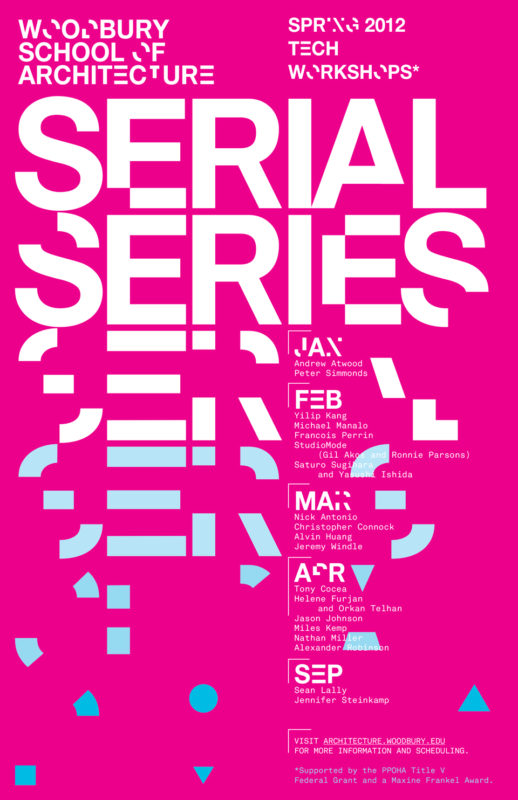Workshops organized with the insight of Ewan Branda, David Freeland, Jason King, Maxi Spina, and Linda Taalman.
Graphic Design: 23in
***
Serial Series was a group of hands-on technology workshops held at Woodbury School of Architecture in Spring 2012. Under its moniker, the leading developers and practitioners of computational imaging and modeling hardwares, platforms, and softwares shared their expertise with students, faculty, and University affiliates.
The semester-long event coincided with the opening of the campus digital fabrication facilities and was conceived as a means of inspiring the integration of the new resources into the curriculum. Through classroom visits and weekend immersions, the capability showcasing did much to enliven the school’s maker culture and elevate production standards.
Reports from the four mainstay visits follow.
***
Studio Mode/modeLab
February 11-12, 2012
This past weekend, Brooklyn-based Gil Akos and Ronnie Parsons of Studio Mode/modeLab flew in to lead a group of approximately forty students and faculty through incrementally sophisticated exercises in the Rhino / Grasshopper interface. Akos and Parsons, as faculty at Pratt and through their research studio, embrace an open-source philosophy with regards to their computational expertise. By sharing their insider techniques in workshops across the country, they aim to push the conversations around advanced technologies beyond the devices and towards design innovation.
Intense and fast-paced, Studio Mode/modeLab covered a huge scope of material in the two 8-hour sessions and exposed participants both to the constructive logics of the softwares and to the potentials of the applications. Students appreciated the in-depth, step-by-step explanations of how to use the Grasshopper components. They were wowed by the formal, patterned, and spatial repercussions of every decision in the programming design process.
Thank you Studio Mode/modeLab and workshop participants. We are excited to inject this kind of thinking into design studio. The dissemination of digital facility gives students the tools to push the boundaries of this software and ideally will give rise to new architectures.
***
Satoru Sugihara with Yasushi Ishida
February 18, 25, March 3, 10, 2012
Here in Serial Series, we are in the midst of a four weekend long scripting immersion. Satoru Sugihara is giving us, the students and faculty, a personally guided tour through his iGeo online tutorial library. Sugihara, who is a designer with a background in computer science, developed iGeo’s customized interface as an architecturally tailored co-option of the Processing platform for visual programmers. We are the first-hand benefactors of explanations of the logics behind the spectacular digital output of this parametric command system.
Diving directly into the deep end in the first two sessions, we covered “multi-agent algorithms”, the manipulation of geometries and aggregations through influential computational entities, and “physics and swarm simulations”, the application of equations for the mimicry of the pattern and performance of real-world behaviors.
With two weekends left, we’ll spend the rest of the time refining our understanding of these two lessons. Then, we’ll translate what we have learned into unique digital models. The work will be exhibited for the campus community as graphics and 3d prints at the end of March.
***
Christopher Connock
March 10-11, 2012
“Hi, My name is Christopher and I love catenary curves.”
With that simple introduction, Christopher Connock, a New York-based designer and a recent graduate of Yale School of Architecture, explained how he became a visual software polymath. Out of an obsession with the physics of draped form, he dedicated himself to the accurate depiction of the aesthetics and behavior of hanging cable.
We, at Serial Series, benefited from Connock’s mission and the knowledge that he accumulated on his focused quest. Over the March 10-11 weekend workshop, he demonstrated how to tailor and surf through computational platforms in pursuit of desired design outcomes. He guided us across and between Rhino, Grasshopper, Kangaroo, and Processing, revealing the capacities, limitations, and compatibilities of each program. And, through the journey, he provoked an appreciation for the continuation of Gaudi’s gravity studies in all of us.
While the software prowess is his apparent workshop contribution, Connock’s real lesson is the dexterity that is achievable through a singular drive.
***
Jason Kelly Johnson
April 7, 2012
Responsive Surfaces, the final workshop of Serial Series Spring 2012 led by Future Cities Lab’s Jason Johnson, connects dots between computation and reality. The workshop closed the feedback loop between the outputs of the components of the Arduino Uno console and the inputs for the Firefly/Grasshopper/Rhino software. In connecting the hardware and the software, Johnson makes evident the tangible potentials of architecture’s technological revolution.
The Arduino Uno console, like the software that runs it, is an open-source hardware device that is both customizable and hackable. It acts as the command interface between digital scripts and anything that will respond to an electric current.
Under Johnson’s direction, workshop participants spent their Saturday controlling, or enabling, the behavior of LED lights and Servomotors through the Arduino Uno. Determined by coded parameters sent to the console by the computer or prompted by environmental conditions translated into data by sensors, lights blinked and faded and motors sped-up and slowed-down. The changes in plug-in behavior were ooh- and ah- inspiring. A simple shift in a Grasshopper slider or, even more powerfully, in a shadow rolling across the desks, would provoke a mechanical response from the LED lights or Servomotors and a gasp from the students.
Johnson expected the Pavlovian reactions. “You guys are going to get hooked,” he cautioned. “This is just the beginning.”
Participants, understandably, were enticed by the implications that come with immediate influence over their surroundings. The possible applications for the technology are not only infinite in scope, but also are a rich and addictive topic for critical discourse. But, then again, Johnson did warn us that he was introducing us to a gateway drug.

